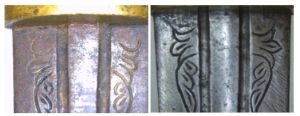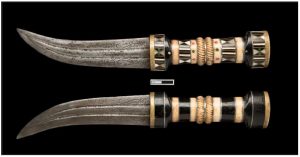December ’19
December’s Object of the Month is a Medjedel dagger.

This medjedel dagger is part of the Oriental Museum’s collection and was donated as part of the Wilfred Dodds collection in 1985. The object is a late 19th/early 20th-century curved double-edged dagger. There’s an Arabic inscription on the blade which translates to ‘Happy work’ and “Mejedel’s own/made’. This style of dagger was identified as a Majdalani dagger which originates from an Israeli Druze town of Majdal Shams. Daggers of this sort were considered artistic but still utilitarian. During the late 19th/early 20th century, many families passed the skill of dagger making to successive generations. The ability to craft daggers of this type was believed to endow one with honour, respect, skill, and wealth. These daggers were made for sale both locally and to surrounding regions where they would be sold in tourist markets.
Conservation

An appropriate abrasive material was used to remove the iron corrosion from the blade, which was then treated with acetone in order to remove any residual dirt and grease. The blade was finally coated with a layer of renaissance microcrystalline wax in order to help protect the surface from future deterioration.

An initial surface clean was performed on the hilt using groomstick as it was minimally invasive and proved successful at removing the surface dust and dirt. A swab, slightly dampened with a suitable solution was then rolled gently over the surface to further remove dirt. The pommel of the hilt showed some signs of past corrosion; these areas were removed using cotton wool swabs and a suitable solvent. This section was then coated with renaissance microcrystalline wax in order to help protect the surface.

There were several missing areas of mother of pearl decoration on the hilt which were to be replicated in order to allow visitors to see the object as a whole and not focus on the missing areas. A quick setting moulding material was used to take an impression of the missing areas of inlay. The same fast setting material was then used to make a mould of the impressions. Finally, a mixture of Paraloid B72 adhesive and glass microballoons were used to create the cast of the missing material. These were then adhered in place and although they didn’t match the originals perfectly they allowed the dagger to be appreciated in full.
Stay tuned for next month’s object!
